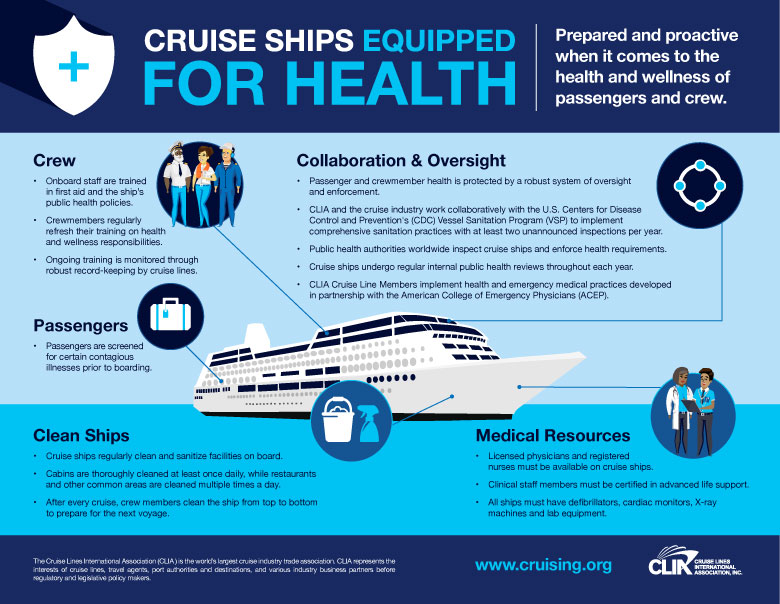Public Health and Medical
Cruise lines go to great lengths to support the health and wellness of all onboard. From cleaning practices to passenger screening and public health inspections, cruise lines work vigorously to keep passengers and crew healthy.
Ensuring Health at Sea
Sanitation
Crewmembers regularly clean and sanitize the ship’s facilities, including:
- Cabins cleaned at least once daily;
- Restaurants and snack areas cleaned regularly; and
- Common areas such as pools and elevators cleaned throughout the day.
At the end of every cruise, crewmembers clean the ship from top to bottom using designated cleaning supplies and sanitation procedures.
Screening
Pre-boarding health screenings help identify ill passengers or crewmembers prior to boarding. The most common health screening protocol is a health questionnaire. Passengers indicate if they or their traveling companions have had any recent symptoms of illness. Passengers and crewmembers who may be ill are assessed by medical staff before they interact with other guests.
Medical Facilities
Cruise Lines International Association (CLIA) Cruise Line Members collaborated with the American College of Emergency Physicians (ACEP) to develop and implement guidelines on cruise ship medical facilities. These guidelines, which are mandatory for CLIA oceangoing Cruise Line Members, specify that cruise ships must have at least one qualified medical professional available 24/7 for medical bay visits or cabin “house calls.” Also, cruise ships must have an examination room, an intensive care room and equipment for processing labs, monitoring vital signs and administering medications. Patients requiring more comprehensive facilities or treatment are typically referred to a shore side medical facility.
Inspected for Health
Passenger and crewmember health is protected by a robust system of oversight and enforcement. Public health authorities worldwide inspect cruise ships and enforce health requirements. Cruise ships calling on U.S. ports, for example, receive at least two unannounced health inspections every year. In addition, cruise ships undergo three or more formal internal public health inspections each year.
Crewmember Training
Onboard staff must be trained in first aid and public health practices. No matter their job onboard, crew must be trained in safety and first aid procedures, such as emergency procedures, signals and alarms; evacuation procedures; and fire prevention and fire safety.
Norovirus on Cruise Ships
- Incidents of norovirus or other gastrointestinal (GI) disease are quite rare on cruise ships. The Centers for Disease Control and Prevention (CDC) reports that 20 million people on land in the U.S. come down with norovirus every year.
- In the U.S., the risk of getting norovirus each year is about 1 in 15; a cruise passenger has about a 1 in 5,500 risk of getting laboratory-confirmed norovirus during a shipboard outbreak.


